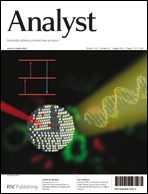An electrophoretic method for the separation of derivatised mono- and di-saccharides with on-line concentration via dynamic pH junction has been developed and optimised in capillaries. Dynamic pH junction is perfectly suited for on-line concentration of derivatised sugars due to the acidic derivatisation conditions, however, most reagents for carbohydrates are not ionisable, requiring the use of the novel reagent, O-2-[aminoethyl]fluorescein. Optimisation of the separation selectivity yielded best separations with 170 mM ammonium borate buffer at pH 8.60 in an acrylamide coated capillary. When using an injection comprising 7% of the capillary volume and detection via laser induced fluorescence (LIF) with an argon ion laser, limits of detection as low as 0.13 nM for maltose were obtained, which was 10 times lower than could be achieved without on-line concentration. In order to implement this system in a glass/PDMS microchip, the low pH sample was introduced into the microchannels via a cathodic pH independent electro-osmotic flow (EOF) generated using a poly(dimethyldiallylmethyl-ammonium chloride) (PDADMAC)/poly(styrene sulfonate) (PSS) polyelectrolyte multilayer coating. Optimisation of the injection volume in capillaries greatly simplified translation to the microchip platform, with the optimum capillary sample volume of 7%, dictating the use of an off-set cross with a volume 7% of the separation channel. Microchip separations of maltose, glucose, galactose and allose with dynamic pH junction, were achieved within 120 s, with the limit of detection of maltose using a light emitting diode induced fluorescence (LEDIF) detection system being 790 nM. This is 10 times lower than that achieved without concentration, and is lower than other reports of derivatised sugars using LEDIF detection. This is the first implementation of on-line concentration via a dynamic pH junction in a microchip, and significantly, the improvement in sensitivity achieved when translated to the microchip was equivalent to that achieved in capillaries.


 Please wait while we load your content...
Please wait while we load your content...